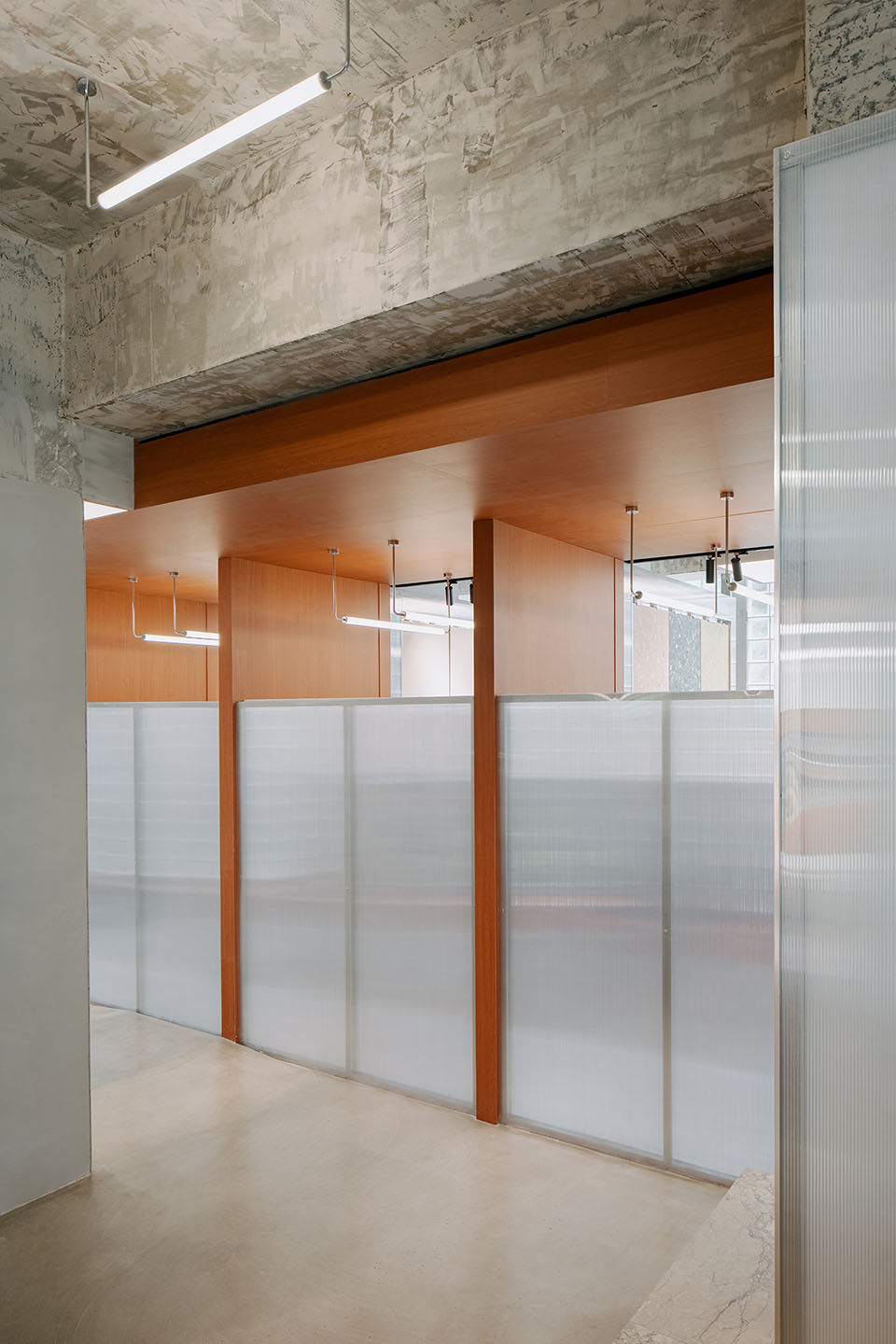
©吕晓斌
项目背景
互联网新零售品牌正面临后疫情经济与低碳经济双重挑战。线下空间体验、易循环等成为新零售的关键词。作为典型的新零售建材品牌,小火柴瓷砖也面临同样的问题。他们新展厅的场地位于一栋地上三层、地下一层的建筑内。建筑外部被玻璃砖包裹,采光优良。内部空间秩序混乱、缺乏记忆点。
Project Background
New internet retail brands are facing dual challenges of post pandemic economy and low-carbon economy. Offline space experience and easy circulation have become keywords for new retail. As a typical new retail building materials brand, Little Match Tiles also faces the same problem. The venue of their new exhibition hall is located in a building with three floors above ground and one floor underground. The exterior of the building is wrapped in glass bricks, providing excellent lighting. The internal space is chaotic and lacks memory points.
——————
项目名称:小火柴瓷砖展厅
项目类型:展厅室内设计、零售室内设计
设计方:栖斯设计
小火柴瓷砖展厅 栖斯设计
Small Match Tile Exhibition Hall Qisi Design
---
设计概念
栖斯没有优先考虑陈展功能,而是在有限的预算内着力打造空间的包容性、辨识度以及场所精神。栖斯针对每层场地的特点,以高效的空间构形策略建立起秩序。该策略旨在利用基本的空间形式操作,在尽量少的空间干预下营造丰富的体验。此外,栖斯平衡了固定要素与易循环要素的比例,使展厅呈现独特的个性与美感。栖斯在有限的资源内为当下的建材零售空间提供了一种可行范本。。
Design Concept
Qisi did not prioritize the exhibition function, but instead focused on creating space inclusivity, recognition, and place spirit within a limited budget. Qisi establishes order based on the characteristics of each floor of the site through efficient spatial configuration strategies. This strategy aims to utilize basic spatial forms of operation to create a rich experience with minimal spatial intervention. In addition, Qisi balances the proportion of fixed elements and easily recyclable elements, giving the exhibition hall a unique personality and beauty. Qisi provides a feasible model for the current retail space of building materials within limited resources.

©吕晓斌

©吕晓斌
展厅一层
栖斯用三个盒体整理了首层空间。一个长条形的盒子从室内延伸至室外。起入口引导与内外过渡的作用。栖斯利用灯阵的节奏隐藏了入口上方的梁,让长条形盒子内外连贯。包裹建筑核心筒的盒体容纳了水吧、展示、收纳、导视等功能并且统筹了杂乱的界面。铺满瓷砖的盒子通过隐形门隐藏了后方的内部办公空间。盒体之外则保持场地原始状态,贯彻最小化干预的策略。梳理后的空间变得清晰、简明且极具辨识度。
Exhibition Hall First Floor
Qisi organized the first floor space with three boxes. A long strip shaped box extends from indoors to outdoors. The role of entrance guidance and internal and external transition. Qisi used the rhythm of the lamp array to hide the beam above the entrance, making the long box coherent inside and outside. The box body that wraps around the core cylinder of the building accommodates functions such as a water bar, display, storage, and navigation, and coordinates a messy interface. The tiled box hides the internal office space behind it through a hidden door. Outside the box, maintain the original state of the site and implement a strategy of minimizing intervention. The sorted space becomes clear, concise, and highly recognizable.

©吕晓斌

©吕晓斌

©吕晓斌

©吕晓斌

©吕晓斌
从负一层入口进入场地后首先会经过一段走廊。左侧是高密度瓷砖展区,右侧是产品拍摄区和仓库。产品拍摄过程对外展示。这将建材与摄影艺术进行了嫁接,激发了顾客的好奇心也同时表达了品牌方的坦诚。
After entering the venue from the entrance of the first floor, you will first pass through a section of corridor. On the left is the high-density ceramic tile exhibition area, while on the right is the product shooting area and warehouse. The product shooting process is displayed externally. This grafting of building materials and photography art has stimulated customers' curiosity and expressed the brand's honesty.

©吕晓斌

©吕晓斌

©吕晓斌

©吕晓斌

©吕晓斌
高密度展区的空间构形策略是:以空间中部的四根结构柱为边界,设置内外两层展区。再通过展台与墙面构造共同建构空间比例系统。中部的盒体是用于瓷砖样品检测的实验室。盒子的落位偏离中心,用于兼顾不同视点的视觉体验。
The spatial configuration strategy of high-density exhibition areas is to set up an inner and outer exhibition area with four structural columns in the middle of the space as the boundary. Then, through the construction of exhibition stands and walls, a spatial proportion system is jointly constructed. The box in the middle is a laboratory for testing ceramic tile samples. The positioning of the box deviates from the center, which is used to balance the visual experience of different viewpoints.

©吕晓斌

©吕晓斌

©吕晓斌
36个成品展架均从原展厅搬来进行二次利用。栖斯将展架排列成组,并在外侧包裹木作统一形态。台面的方格用于归置样块。强烈的秩序有助于统筹不同风格的瓷砖。这也让人联想到首饰、化妆品展柜,增加顾客对建材的亲切感。
All 36 finished exhibition stands have been moved from the original exhibition hall for secondary utilization. Qisi arranged the exhibition shelves into groups and wrapped them with wooden work on the outside to form a unified form. The square of the countertop is used to place the sample blocks. A strong order helps to coordinate different styles of tiles. This also reminds people of jewelry and cosmetics display cabinets, increasing customers' familiarity with building materials.

©吕晓斌
栖斯以占据中部空间的一排斜钢柱为线索,将承载瓷砖展品的片墙环绕中部区域布置。路径穿过展墙,形成了阵列的门洞。每两个门洞之间的空间形成一个独立的展区,用于展示相同类型的产品。当顾客看完一个类型的展区,前往下一展区时会穿过门洞。门洞被刻意压低,强化穿行的感受。虽然每个展区间隔很近,但是门洞加强了各展区的独立性。
Qisi uses a row of inclined steel columns occupying the central space as a clue to surround the central area with the walls carrying ceramic tile exhibits. The path passes through the exhibition wall, forming an array of door openings. The space between each two door openings forms an independent exhibition area for displaying products of the same type. When customers finish viewing a type of exhibition area and go to the next exhibition area, they will pass through the door opening. The door opening is deliberately lowered to enhance the feeling of passing through. Although each exhibition area is closely spaced, the door opening enhances the independence of each exhibition area.

©吕晓斌

©吕晓斌

©吕晓斌

©吕晓斌
瓷砖展架由外覆阳光板的方钢搭建。轻与重产生了有趣的对比。展架采用装配式安装,便于使用周期结束后的回收以及重复利用。展架的尺寸根据瓷砖模数设置,便于灵活陈展不同的产品。这一基本元素构建出一个秩序、灵活、包容的空间系统。
The ceramic tile exhibition stand is constructed of square steel covered with sunlight panels. Light and heavy create an interesting contrast. The exhibition stand is installed in an assembled manner, making it easy to recycle and reuse after the end of the usage cycle. The size of the exhibition stand is set according to the tile module, making it easy to display different products flexibly. This basic element constructs an orderly, flexible, and inclusive spatial system.

©吕晓斌

©吕晓斌

©吕晓斌

©吕晓斌
品牌方对三层的定位是通过实景展示瓷砖三维铺贴的效果。栖斯利用顶层的层高优势,用盒体、台阶、平台构建出一个微型街区系统。“街区”这一空间原形既能陈展也能被用作品牌发布、沙龙以及商业拍摄等。这有别于样板间式的陈展方式。样品瓷砖被有机的安排在“街区”各处,形成了一个超现实乌托邦。人穿行其中获得自由观察的体验。
The brand's positioning for the third floor is to showcase the three-dimensional tiling effect through real-life displays. Qisi utilizes the height advantage of the top floor to construct a micro block system using boxes, steps, and platforms. The original form of the "block" space can be used for both exhibition and brand release, salons, and commercial photography. This is different from the showroom style display method. The sample tiles are organically arranged throughout the 'block', forming a surreal utopia. People experience freedom of observation through it.

©吕晓斌

©吕晓斌

©吕晓斌

©吕晓斌

©吕晓斌

©吕晓斌

©吕晓斌

©吕晓斌

©吕晓斌

©吕晓斌

©吕晓斌

©吕晓斌

©吕晓斌

©吕晓斌
项目信息
项目名称:小火柴瓷砖展厅
项目类型:展厅室内设计、零售室内设计
设计方:栖斯设计
公司网站:https://www.qisidesign.com/
联系邮箱:qisi_design@163.com
项目设计:2022
完成年份:2023
设计团队:主创:陈茜茜、傅翀 团队成员:单仁杰
项目地址:上海市闵行区芦恒路
建筑面积:1000.2498809㎡
摄影版权:吕晓斌
客户:小火柴瓷砖
材料:瓷砖、木饰面
品牌:小火柴瓷砖、仙人掌照明
版权©策站网cezn.cn,欢迎转发,禁止以策站编辑版本进行任何形式转载